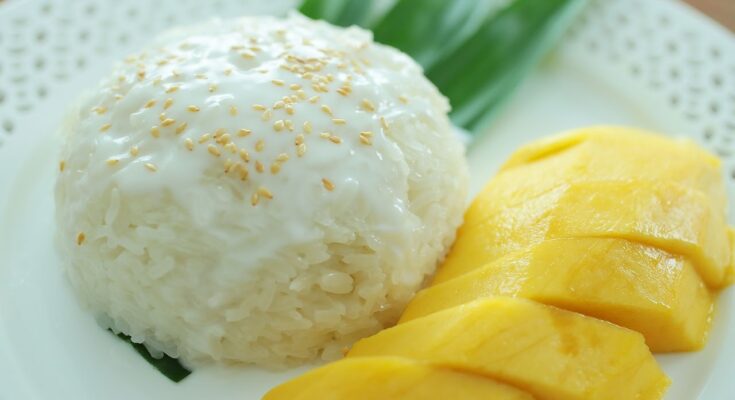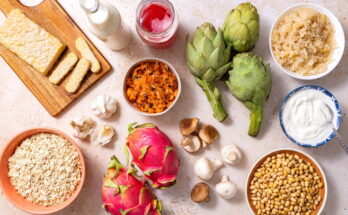Glutinous Rice Recipe: There’s something incredibly comforting about a bowl of perfectly cooked glutinous rice. Whether it’s the star of a sweet dessert or a savory side, its chewy, sticky texture and subtle flavor make it irresistible. Popular across Asia—from Thailand and Vietnam to China and Japan—glutinous rice has become a staple in global kitchens, appreciated for its versatility and satisfying bite. If you’ve been wanting to master this classic dish at home, you’re in the right place.
In this comprehensive, step-by-step guide, you’ll learn how to cook glutinous rice like a pro, with simple instructions, expert tips, and creative variations. Let’s dive in!
What Is Glutinous Rice?
Glutinous rice—also known as sticky rice, sweet rice, or waxy rice—is a type of rice grown mainly in Southeast and East Asia. Don’t be fooled by the name; it’s entirely gluten-free. The term “glutinous” refers to the glue-like, sticky consistency it develops when cooked.
You’ll often find it used in:
- Thai mango sticky rice
- Chinese zongzi (rice dumplings)
- Japanese mochi
- Lao and Vietnamese desserts
The sticky nature comes from its high amylopectin and low amylose content, which affects how the starch behaves during cooking. Instead of turning fluffy like basmati or jasmine rice, glutinous rice clumps together—perfect for forming balls, wrapping in banana leaves, or eating with your hands.
Its importance in Asian cuisine goes beyond taste—it’s deeply rooted in traditions, ceremonies, and celebrations. Whether it’s offered during ancestral worship in China or served during Thai New Year, glutinous rice carries emotional and cultural weight.
Health Benefits of Glutinous Rice
Believe it or not, glutinous rice isn’t just delicious—it’s got some surprising health perks too. While it’s not as fiber-rich as brown rice, it provides clean carbohydrates that can be a great energy source, especially for those who lead active lifestyles.
Some key benefits include:
- Gluten-Free Goodness: Despite its name, glutinous rice is completely gluten-free. This makes it an excellent option for people with celiac disease or gluten sensitivity.
- Easily Digestible: Its soft texture makes it gentle on the stomach, ideal for those recovering from illness or with digestive issues.
- Source of Minerals: Depending on the variety (especially the black or purple kind), glutinous rice can be rich in antioxidants, zinc, and magnesium.
- Satiating: Thanks to its chewy consistency, glutinous rice leaves you feeling fuller for longer, potentially reducing snacking between meals.
Just remember—because it has a high glycemic index, those watching their blood sugar levels should enjoy it in moderation or pair it with fiber-rich foods and protein.
Types of Glutinous Rice
Not all sticky rice is the same. In fact, there’s a world of variety within glutinous rice that can change the flavor, texture, and even color of your final dish.
White Glutinous Rice
The most common type. It turns bright white and glossy when cooked. Often used in Thai and Chinese dishes.
Black (or Purple) Glutinous Rice
Naturally rich in antioxidants and has a nuttier, earthier flavor. It’s perfect for desserts and looks stunning on the plate.
Short-Grain vs. Long-Grain
- Short-grain glutinous rice: Stickier and denser. Ideal for mochi and sweet rice balls.
- Long-grain glutinous rice: Less sticky, more defined texture. Great for savory dishes like Lao sticky rice.
Each type lends itself to different recipes, so choose according to your needs and the dish you’re planning to create.
Choosing the Right Glutinous Rice
When buying glutinous rice, not all bags are created equal. Here’s what to consider:
Top Brands to Look For:
- Three Rings (Thailand)
- Golden Phoenix
- Erawan
- Sunlee
What to Look For:
- Short or long grain, depending on recipe
- Uniform color
- Minimal broken grains
- Vacuum-sealed or fresh packaging
You can typically find glutinous rice in Asian grocery stores, international sections of supermarkets, or online platforms like Amazon.
List of Ingredients You’ll Need
Here’s everything you’ll need for the basic glutinous rice recipe:
Essential Ingredients:
- 2 cups glutinous rice
- Water (for soaking and steaming)
Optional Add-Ons:
- Pinch of salt
- Coconut milk (for sweetness)
- Pandan leaves or banana leaves (for aroma)
- Sugar or palm sugar
- Toasted sesame seeds or mung beans
Want to take it to the next level? Try adding:
- Sliced mango
- Grilled pork
- Chinese sausage
- Crushed peanuts
These additions can turn your sticky rice into a complete meal or a show-stopping dessert.
Tools and Equipment You’ll Need
While traditional methods involve bamboo steamers, you don’t need fancy equipment to cook great sticky rice. But here are your options:
Traditional Tools:
- Bamboo steamer basket
- Sticky rice pot (aluminum steaming pot)
Modern Alternatives:
- Metal steaming basket in a large pot
- Rice cooker with a sticky rice setting
- Instant Pot with steamer rack or rice setting
Also, keep on hand:
- Fine-mesh strainer
- Large mixing bowl (for soaking)
- Wooden spoon or rice paddle
How to Prepare Glutinous Rice – Step-by-Step Guide
Cooking glutinous rice might seem intimidating, but trust me—it’s a breeze once you’ve done it a few times. Here’s your foolproof method:
Step 1: Rinse the Rice
Rinse 2 cups of glutinous rice in cold water, swishing it around gently with your fingers. Drain and repeat 2–3 times until the water runs mostly clear. This removes surface starch and helps prevent the rice from getting too gummy.
Step 2: Soak the Rice
Place the rinsed rice in a bowl and add enough water to cover it by at least 2 inches. Soak for 4–6 hours or overnight. This step ensures even cooking and that perfectly sticky texture.
Step 3: Drain the Rice
After soaking, drain the rice using a fine-mesh strainer. Let it sit for a few minutes to get rid of excess water. Don’t skip this step—too much moisture will throw off the steaming process.
Step 4: Steam the Rice
Place the soaked rice in a steamer lined with cheesecloth or banana leaf. Steam over medium-high heat for 25–30 minutes. About halfway through, gently flip the rice for even cooking. You’ll know it’s done when the grains turn translucent and tender.
Step 5: Let It Rest and Serve
Once cooked, transfer the rice to a bowl, cover with a damp towel, and let it rest for 5–10 minutes. This helps it firm up. Then fluff with a spoon and serve hot.
Common Mistakes to Avoid
Cooking glutinous rice seems simple, but a few missteps can totally ruin its texture. Here are the most common mistakes and how to dodge them like a kitchen ninja:
1. Skipping the Soak
This is a big one. If you skip soaking your rice, the grains will cook unevenly—some will be mushy, others still hard in the center. Glutinous rice needs that long soak (at least 4 hours, ideally overnight) to absorb water slowly and cook evenly.
2. Not Rinsing Thoroughly
Rinsing isn’t just a rinse-and-go deal. You need to rinse the rice several times to remove excess starch, which can make the rice overly sticky or gluey instead of giving you that perfect chew.
3. Steaming Too Soon or Without Even Layers
Don’t pile your rice into a huge mound in the steamer. Keep it evenly spread out for uniform cooking. If it’s packed too tightly, the center won’t steam through and you’ll get undercooked patches.
4. Using the Wrong Cooking Method
Glutinous rice isn’t like jasmine or basmati rice—it should never be boiled like regular rice. Boiling will make it soggy and gummy. Always steam it or use a rice cooker with a sticky rice setting.
5. Not Covering Properly During Steaming
If steam escapes too easily, your rice will dry out. Always cover the steamer lid tightly and line with a cloth to trap that precious steam inside.
Avoid these, and you’ll be on your way to glutinous rice perfection.
Flavor Variations
One of the best parts about glutinous rice? It’s like a blank canvas. You can dress it up with sweet or savory flavors, making it suitable for everything from desserts to main dishes.
1. Coconut Milk Sticky Rice
- Replace water with coconut milk for a creamy, sweet twist.
- Add sugar and a pinch of salt during steaming.
- Best served with mango slices for that classic Thai dessert.
2. Savory Sticky Rice with Chinese Sausage
- Mix in thin slices of Chinese sausage (lap cheong), mushrooms, and scallions after steaming.
- Add a splash of soy sauce and sesame oil for umami goodness.
3. Black Sticky Rice Pudding
- Use black glutinous rice and cook it in sweetened coconut milk.
- Top with roasted sesame seeds, banana slices, or a drizzle of honey.
4. Lao-Style Sticky Rice
- Keep it simple—steam and serve with spicy papaya salad and grilled meats.
- Eat with your hands and enjoy the traditional Lao dining experience.
These variations allow you to customize your rice to match the vibe of your meal—be it a festive dessert or a hearty dinner.
How to Store and Reheat Glutinous Rice
Made a little too much? No worries—sticky rice stores pretty well with the right technique.
Storing:
- Let the rice cool completely before storing.
- Place in an airtight container or wrap tightly in plastic wrap.
- Store in the fridge for up to 3 days.
Freezing:
- Portion into individual servings.
- Wrap in cling film or store in freezer-safe bags.
- Freeze for up to 1 month.
Reheating:
- Microwave: Sprinkle rice with a little water, cover with a damp paper towel, and microwave in 30-second bursts.
- Steamer: Re-steam for 5–10 minutes until soft and warm.
- Pan Method: Add a splash of water, cover, and gently heat over low heat.
Tip: Never reheat sticky rice dry—adding moisture is key to reviving its soft texture.
Serving Suggestions
Wondering what to serve with your glutinous rice masterpiece? Here are some ideas to get your creative juices flowing:
Sweet Pairings:
- Mango slices + coconut cream
- Taro paste + sesame seeds
- Sweetened red bean paste
- Sliced banana with palm sugar drizzle
Savory Combinations:
- Grilled chicken or pork skewers
- Spicy papaya salad (Som Tam)
- Fried shallots and garlic oil
- Steamed fish with ginger
For a Full Meal:
- Serve sticky rice alongside main dishes in a bento box.
- Wrap it in banana leaves with fillings like pork, mushrooms, or egg for a portable snack (like zongzi or sticky rice parcels).
- Use as a base for a rice bowl with veggies, sauce, and protein.
Whether you’re cooking for a family dinner or a special occasion, sticky rice can elevate almost any dish.
Glutinous Rice for Desserts
Glutinous rice isn’t just a savory side—it shines in desserts. Here are some of the most delicious ways to sweeten the deal:
Mango Sticky Rice
- Steam the rice and mix with sweetened coconut milk.
- Serve with ripe mango and a sprinkle of toasted mung beans.
Sticky Rice Balls (Tangyuan or Mochi)
- Fill balls of glutinous rice dough with red bean paste or sesame filling.
- Boil until they float, then serve in sweet ginger syrup.
Sticky Rice Cake (Bánh Tét or Nian Gao)
- A traditional treat during Lunar New Year.
- Made with glutinous rice flour, coconut milk, and sugar, then steamed and sliced.
Black Sticky Rice Pudding
- Nutty, slightly sweet, and perfect with a swirl of condensed milk or coconut cream.
These desserts are rich, chewy, and deeply satisfying—perfect for indulging or sharing.
Vegan and Gluten-Free Modifications
Good news—glutinous rice is naturally gluten-free and vegan! But depending on the ingredients you add, you may need to make a few tweaks.
Gluten-Free Tips:
- Avoid adding soy sauce unless it’s specifically labeled gluten-free.
- Stick to natural ingredients like coconut milk, fruits, and veggies.
Vegan Modifications:
- Use plant-based coconut milk.
- Skip any animal-based additions like pork, eggs, or fish sauce.
- For savory recipes, flavor with tamari, miso, or vegan oyster sauce.
By being mindful, you can easily make glutinous rice recipes inclusive for all diets without sacrificing flavor or texture.
FAQs about Glutinous Rice Recipe
1. How long should I soak glutinous rice before cooking?
You should soak glutinous rice for at least 4 hours, but overnight soaking (up to 12 hours) is ideal for the best texture and even cooking.
2. Can I cook glutinous rice without a steamer?
Yes! While steaming is traditional, you can also use a rice cooker with a sticky rice setting or an instant pot. Just be sure not to boil it like regular rice.
3. Is glutinous rice healthy?
Glutinous rice is gluten-free, easy to digest, and a good source of energy. However, it has a high glycemic index, so those with blood sugar concerns should eat it in moderation.
4. Can I freeze cooked glutinous rice?
Absolutely. Wrap it tightly and store it in the freezer for up to 1 month. Reheat with a bit of moisture to restore its soft, sticky texture.
5. What’s the difference between jasmine rice and glutinous rice?
Jasmine rice is fluffy and aromatic, while glutinous rice is chewy and sticky. The starch content is different, which affects the cooking method and final texture.
Conclusion
Glutinous rice is more than just food—it’s a culinary experience deeply rooted in culture, flavor, and tradition. Whether you’re enjoying it in a savory Lao meal or transforming it into a sweet Thai dessert, one thing’s for sure: when made right, it’s unforgettable.
The process may seem a bit involved at first—rinsing, soaking, steaming—but once you’ve done it, you’ll realize how rewarding it is. The key is patience and precision. Choose the right rice, treat it gently, and steam it with care.
So now that you know all the steps and tips, why not give it a try? You might just fall in love with this humble grain’s chewy charm.



